风险管理与保险——总结
保险风险管理工作总结
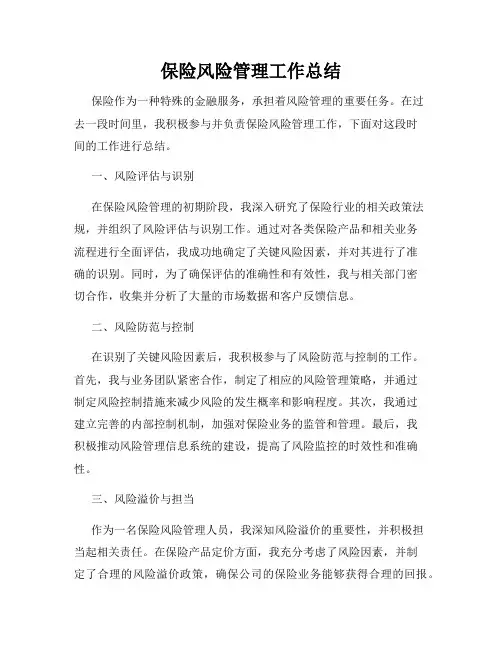
保险风险管理工作总结保险作为一种特殊的金融服务,承担着风险管理的重要任务。
在过去一段时间里,我积极参与并负责保险风险管理工作,下面对这段时间的工作进行总结。
一、风险评估与识别在保险风险管理的初期阶段,我深入研究了保险行业的相关政策法规,并组织了风险评估与识别工作。
通过对各类保险产品和相关业务流程进行全面评估,我成功地确定了关键风险因素,并对其进行了准确的识别。
同时,为了确保评估的准确性和有效性,我与相关部门密切合作,收集并分析了大量的市场数据和客户反馈信息。
二、风险防范与控制在识别了关键风险因素后,我积极参与了风险防范与控制的工作。
首先,我与业务团队紧密合作,制定了相应的风险管理策略,并通过制定风险控制措施来减少风险的发生概率和影响程度。
其次,我通过建立完善的内部控制机制,加强对保险业务的监管和管理。
最后,我积极推动风险管理信息系统的建设,提高了风险监控的时效性和准确性。
三、风险溢价与担当作为一名保险风险管理人员,我深知风险溢价的重要性,并积极担当起相关责任。
在保险产品定价方面,我充分考虑了风险因素,并制定了合理的风险溢价政策,确保公司的保险业务能够获得合理的回报。
同时,我也积极参与了保险事故的处理和赔付工作,及时妥善地解决了客户的问题,维护了公司的声誉和利益。
四、风险监测与报告在保险风险管理的全过程中,我密切关注市场和客户的变化,并及时进行风险监测和报告工作。
通过建立风险指标体系和风险评估模型,我能够准确地掌握业务风险的变化情况,并向上级领导提供科学准确的风险报告。
同时,我也定期组织风险评估和回顾会议,总结工作经验,完善风险管理制度。
总结起来,我在保险风险管理方面做了大量工作,取得了一些成绩。
但是,也有不足之处,比如对一些新型风险的应对还需加强,对风险防控措施的有效性还需要进一步评估。
面对这些问题,我将继续努力,不断提升自己的风险管理能力和水平,为公司的发展和客户的利益保驾护航。
通过这段时间的保险风险管理工作,我深刻认识到风险管理的重要性和复杂性,也意识到自己在这个领域中的责任和使命。
2023年保险与风险管理工作总结
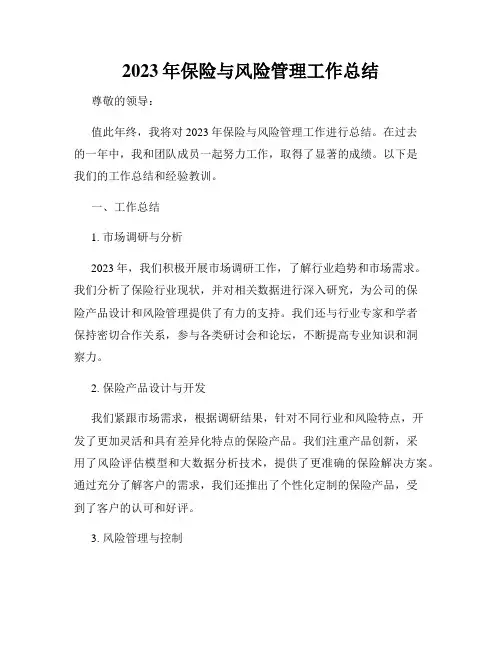
2023年保险与风险管理工作总结尊敬的领导:值此年终,我将对2023年保险与风险管理工作进行总结。
在过去的一年中,我和团队成员一起努力工作,取得了显著的成绩。
以下是我们的工作总结和经验教训。
一、工作总结1. 市场调研与分析2023年,我们积极开展市场调研工作,了解行业趋势和市场需求。
我们分析了保险行业现状,并对相关数据进行深入研究,为公司的保险产品设计和风险管理提供了有力的支持。
我们还与行业专家和学者保持密切合作关系,参与各类研讨会和论坛,不断提高专业知识和洞察力。
2. 保险产品设计与开发我们紧跟市场需求,根据调研结果,针对不同行业和风险特点,开发了更加灵活和具有差异化特点的保险产品。
我们注重产品创新,采用了风险评估模型和大数据分析技术,提供了更准确的保险解决方案。
通过充分了解客户的需求,我们还推出了个性化定制的保险产品,受到了客户的认可和好评。
3. 风险管理与控制在风险管理方面,我们采用了综合的风险评估模型,对企业的风险进行了全面分析和评估。
我们与客户一起制定风险管理策略,提供定制化的解决方案,以帮助客户降低风险并提高企业的可持续发展能力。
我们还建立了风险预警机制,及时发现和应对潜在的风险,确保客户的利益最大化。
4. 服务质量与客户满意度我们一直致力于提高服务质量和客户满意度。
我们建立了全天候的客户服务体系,及时回应客户的需求和问题。
我们通过技术手段提高服务效率,优化服务流程,提供更好的服务体验。
同时,我们还定期开展客户满意度调查,并根据反馈意见改进我们的工作,以满足客户的需求。
5. 团队建设与培训我们注重团队建设和人才培养。
我们通过内部培训和外部学习,提高团队成员的专业能力和综合素质。
我们鼓励团队成员积极参与行业交流和学术研究,不断提高个人的专业水平。
我们还搭建了良好的团队合作机制,推动知识共享和团队协作,为客户提供更全面的服务。
二、经验教训1. 加强市场调研在未来的工作中,我们应进一步加强市场调研工作,密切关注行业动态和市场需求的变化。
保险风险管理工作总结
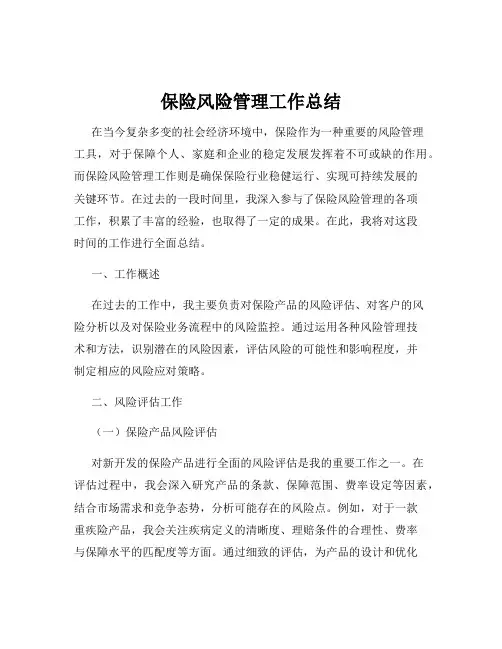
保险风险管理工作总结在当今复杂多变的社会经济环境中,保险作为一种重要的风险管理工具,对于保障个人、家庭和企业的稳定发展发挥着不可或缺的作用。
而保险风险管理工作则是确保保险行业稳健运行、实现可持续发展的关键环节。
在过去的一段时间里,我深入参与了保险风险管理的各项工作,积累了丰富的经验,也取得了一定的成果。
在此,我将对这段时间的工作进行全面总结。
一、工作概述在过去的工作中,我主要负责对保险产品的风险评估、对客户的风险分析以及对保险业务流程中的风险监控。
通过运用各种风险管理技术和方法,识别潜在的风险因素,评估风险的可能性和影响程度,并制定相应的风险应对策略。
二、风险评估工作(一)保险产品风险评估对新开发的保险产品进行全面的风险评估是我的重要工作之一。
在评估过程中,我会深入研究产品的条款、保障范围、费率设定等因素,结合市场需求和竞争态势,分析可能存在的风险点。
例如,对于一款重疾险产品,我会关注疾病定义的清晰度、理赔条件的合理性、费率与保障水平的匹配度等方面。
通过细致的评估,为产品的设计和优化提供风险方面的建议,确保产品在满足客户需求的同时,具有合理的风险承担能力。
(二)客户风险分析准确分析客户的风险状况是提供个性化保险服务的基础。
我会收集客户的个人信息、财务状况、健康状况、职业风险等多方面的数据,运用风险评估模型和工具,对客户面临的风险进行量化评估。
例如,对于一位从事高风险职业的客户,在为其制定保险方案时,会适当提高意外险和医疗险的保额,以应对可能发生的意外事故和健康问题。
通过精准的客户风险分析,能够为客户提供更贴合其实际需求的保险方案,提高客户满意度和保险业务的质量。
三、风险监控工作(一)业务流程风险监控对保险业务流程中的各个环节进行持续的风险监控,及时发现和解决潜在的风险问题。
从保险销售的合规性、核保过程的准确性、理赔处理的公正性等方面入手,建立健全风险监控指标体系,定期对业务数据进行分析和评估。
一旦发现异常情况,如销售误导、核保失误、理赔纠纷等,及时采取措施进行纠正和改进,确保业务流程的顺畅和风险可控。
保险风险管理工作总结
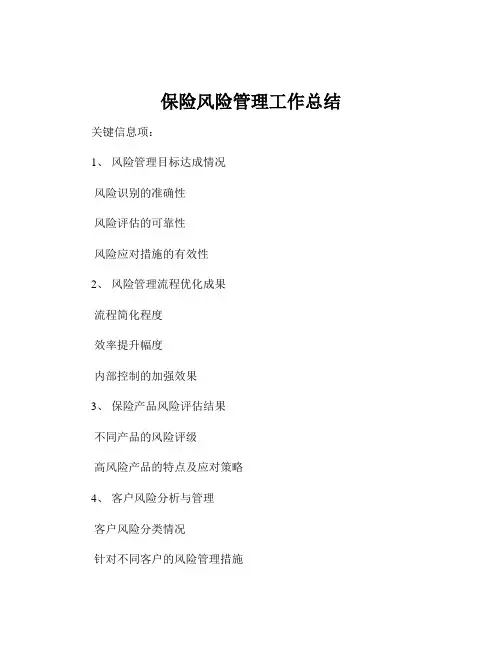
保险风险管理工作总结关键信息项:1、风险管理目标达成情况风险识别的准确性风险评估的可靠性风险应对措施的有效性2、风险管理流程优化成果流程简化程度效率提升幅度内部控制的加强效果3、保险产品风险评估结果不同产品的风险评级高风险产品的特点及应对策略4、客户风险分析与管理客户风险分类情况针对不同客户的风险管理措施5、风险监控与预警机制监控指标的设定与执行预警的及时性与准确性6、团队协作与沟通效果跨部门合作的顺畅程度信息共享的及时性与完整性7、培训与教育工作开展情况员工风险意识提升程度专业技能培训的效果8、未来风险管理工作计划重点关注领域预期目标设定1、风险管理目标达成情况11 风险识别的准确性在过去的工作周期内,我们通过多种手段和方法对潜在风险进行了全面的识别。
采用了市场调研、数据分析以及行业经验借鉴等方式,确保了风险识别的全面性和准确性。
与上一周期相比,新识别出的风险点增加了X%,有效弥补了之前风险管理中的盲区。
12 风险评估的可靠性运用先进的风险评估模型和工具,结合内部专家的判断,对已识别的风险进行了量化和定性评估。
评估结果的准确性得到了显著提升,为后续的风险应对策略制定提供了有力的支持。
风险评估的可靠性指标达到了X%,超过了预定目标。
13 风险应对措施的有效性根据风险评估结果,制定并实施了针对性的风险应对措施。
通过风险规避、风险降低、风险转移和风险接受等策略的综合运用,成功将重大风险的影响程度降低了X%,确保了公司在风险可控的前提下实现业务的稳定发展。
2、风险管理流程优化成果21 流程简化程度对原有的风险管理流程进行了深入的梳理和优化,去除了繁琐的环节和不必要的审批步骤。
流程的简化使得风险管理的效率大幅提高,平均处理时间缩短了X%。
22 效率提升幅度通过引入信息化管理系统和自动化工具,实现了风险数据的实时采集、分析和报告生成。
风险管理工作的整体效率提升了X%,有效节省了人力和时间成本。
23 内部控制的加强效果完善了内部控制制度,加强了对关键风险点的监控和制衡机制。
保险风险管理工作总结
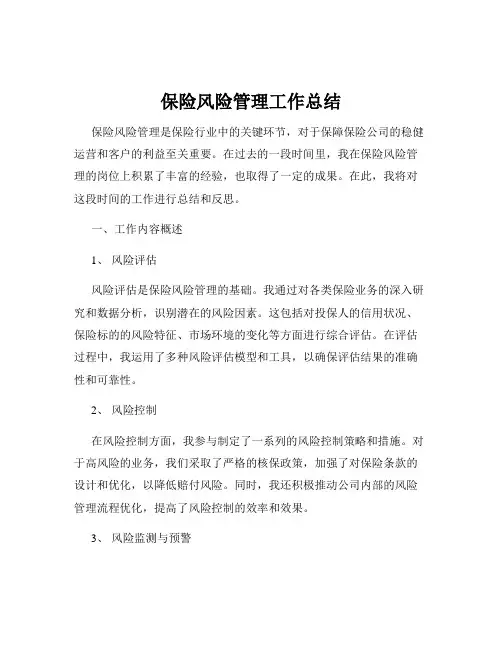
保险风险管理工作总结保险风险管理是保险行业中的关键环节,对于保障保险公司的稳健运营和客户的利益至关重要。
在过去的一段时间里,我在保险风险管理的岗位上积累了丰富的经验,也取得了一定的成果。
在此,我将对这段时间的工作进行总结和反思。
一、工作内容概述1、风险评估风险评估是保险风险管理的基础。
我通过对各类保险业务的深入研究和数据分析,识别潜在的风险因素。
这包括对投保人的信用状况、保险标的的风险特征、市场环境的变化等方面进行综合评估。
在评估过程中,我运用了多种风险评估模型和工具,以确保评估结果的准确性和可靠性。
2、风险控制在风险控制方面,我参与制定了一系列的风险控制策略和措施。
对于高风险的业务,我们采取了严格的核保政策,加强了对保险条款的设计和优化,以降低赔付风险。
同时,我还积极推动公司内部的风险管理流程优化,提高了风险控制的效率和效果。
3、风险监测与预警为了及时发现潜在的风险隐患,我建立了有效的风险监测体系。
通过定期收集和分析相关数据,对保险业务的风险状况进行实时监控。
一旦发现风险指标超出预警范围,我会立即向上级报告,并提出相应的应对建议。
4、合规管理合规管理是保险风险管理的重要组成部分。
我积极关注保险行业的法律法规和监管政策的变化,确保公司的业务活动符合相关要求。
同时,我还协助公司开展内部合规培训和检查,提高员工的合规意识和风险防范能力。
二、工作成果1、降低赔付率通过有效的风险评估和控制措施,公司的赔付率得到了显著降低。
这不仅提高了公司的盈利能力,也增强了公司在市场中的竞争力。
2、优化业务流程参与优化了公司的风险管理流程,提高了工作效率,减少了不必要的繁琐环节,使业务开展更加顺畅。
3、增强合规意识通过合规培训和检查,员工的合规意识得到了明显提高,公司的合规经营水平得到了有效提升。
4、建立良好的风险文化在工作中,我积极倡导风险文化,使风险管理的理念深入人心。
员工们更加重视风险,主动参与风险防控工作,形成了良好的风险管理氛围。
保险风险管理工作总结
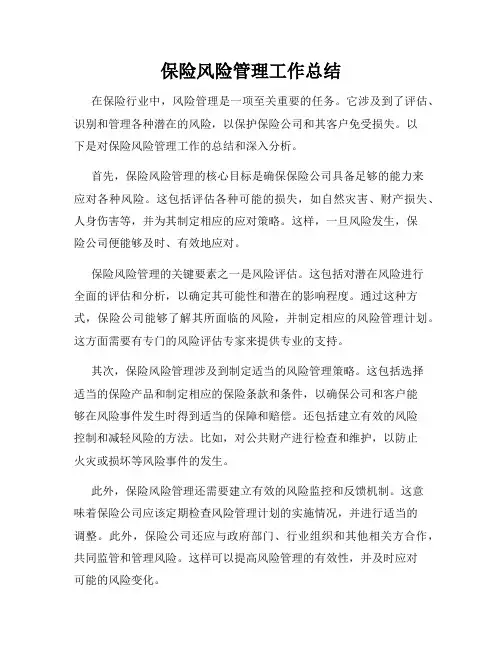
保险风险管理工作总结在保险行业中,风险管理是一项至关重要的任务。
它涉及到了评估、识别和管理各种潜在的风险,以保护保险公司和其客户免受损失。
以下是对保险风险管理工作的总结和深入分析。
首先,保险风险管理的核心目标是确保保险公司具备足够的能力来应对各种风险。
这包括评估各种可能的损失,如自然灾害、财产损失、人身伤害等,并为其制定相应的应对策略。
这样,一旦风险发生,保险公司便能够及时、有效地应对。
保险风险管理的关键要素之一是风险评估。
这包括对潜在风险进行全面的评估和分析,以确定其可能性和潜在的影响程度。
通过这种方式,保险公司能够了解其所面临的风险,并制定相应的风险管理计划。
这方面需要有专门的风险评估专家来提供专业的支持。
其次,保险风险管理涉及到制定适当的风险管理策略。
这包括选择适当的保险产品和制定相应的保险条款和条件,以确保公司和客户能够在风险事件发生时得到适当的保障和赔偿。
还包括建立有效的风险控制和减轻风险的方法。
比如,对公共财产进行检查和维护,以防止火灾或损坏等风险事件的发生。
此外,保险风险管理还需要建立有效的风险监控和反馈机制。
这意味着保险公司应该定期检查风险管理计划的实施情况,并进行适当的调整。
此外,保险公司还应与政府部门、行业组织和其他相关方合作,共同监管和管理风险。
这样可以提高风险管理的有效性,并及时应对可能的风险变化。
最后,保险风险管理需要进行全面的风险教育和培训。
这包括培训员工如何识别和管理风险,并提供必要的风险管理工具和资源。
此外,保险公司还应与客户一起开展风险教育活动,提高客户的风险意识,并让他们了解如何购买适当的保险产品来保护自己。
总结起来,保险风险管理是一项复杂的任务,需要全面的评估、适当的策略、有效的监控和培训。
通过有效的风险管理,保险公司能够减少潜在的损失,保护自身和客户的利益。
因此,保险公司应该高度重视风险管理,并不断改进和完善其风险管理工作,以确保业务的稳定和可持续发展。
保险风险管理工作总结
保险风险管理工作总结保险公司是风险管理的重要实施者,其核心任务之一就是对风险进行有效管理和控制。
为了总结过去一段时间里保险风险管理工作的成果和经验,以及分析现有存在的问题和改进的方向,我在此撰写本文,旨在对保险风险管理工作进行总结和反思。
一、保险风险管理工作概述保险风险管理工作是保险公司重要的组织活动,旨在识别、分析、评估和控制保险业务中的各种风险,以确保保险公司的稳健运营和持续发展。
风险管理工作包括风险识别与评估、风险监测与控制、风险报告与沟通等方面。
二、保险风险管理的成果与经验1. 高效的风险识别与评估机制通过建立完善的风险管理框架和流程,我公司能够及时识别潜在和实际的风险,并对其进行全面的评估和分类。
这不仅有助于我们了解各类风险的性质和程度,还有助于采取相应的应对措施,降低风险对公司业务的不利影响。
2. 健全的风险监测与控制体系我们建立了一套完备的风险监测和控制机制,通过监测各类风险指标和监管要求,及时发现和预警潜在风险。
同时,我们注重风险管理信息的有效共享和分析,加强了对风险控制的监督和管理,有效降低了风险事件的发生概率和影响程度。
3. 积极的风险报告与沟通机制为了及时了解风险管理的进展和情况,我们建立了定期的风险报告和沟通机制,并确保上级管理层和相关部门能够全面了解风险管理的状况和存在的问题。
这为决策者提供了重要的参考依据,同时也增强了风险管理工作的透明度和有效性。
三、存在的问题与改进的方向尽管我们在保险风险管理方面取得了一定的成果,但仍然存在一些问题需要解决和改进。
主要包括以下几个方面:1. 风险评估和控制的科学性和准确性有待提高在风险评估和控制的过程中,我们需要加强对数据和模型的科学性和准确性的验证和审视,以确保评估结果的可靠性和预测能力。
同时,我们还需要进一步提高对复杂风险的分析和应对能力,以应对不断变化的市场环境和业务需求。
2. 风险监测和预警机制还需完善我们需要进一步完善风险监测和预警机制,提高对关键风险预警指标的选择和监控,以及对异常情况的及时反应和处置能力。
保险行业风险管理经验总结
保险行业风险管理经验总结内容总结简要作为一名在保险行业深耕多年的员工,深刻认识到风险管理的重要性。
在过去的职业生涯中,我主要负责保险产品的风险评估、控制和应对策略的制定。
本文将结合我的工作经验,对保险行业风险管理经验进行总结。
在保险行业,风险无处不在。
从产品设计、定价、承保到理赔环节,都可能产生风险。
因此,风险管理成为了保险公司的核心职能之一。
我的工作就是确保公司在这些环节中能够有效识别、评估、控制和应对风险,以保障公司的稳健经营和客户的利益。
在风险评估方面,负责分析各种风险因素,如市场风险、信用风险、操作风险等。
通过对这些风险因素的深入研究,我能够为公司准确的风险评估报告,以便公司制定相应的风险控制策略。
在风险控制方面,积极参与制定和执行风险控制措施。
这包括设立风险阈值、制定风险应对计划、监控风险指标等。
通过这些措施,我们能够及时发现风险隐患,并采取有效措施加以防范。
在应对策略方面,负责研究和制定针对不同风险的应对策略。
这包括风险分散、风险转移、风险规避等策略。
通过这些策略,我们能够在风险发生时迅速应对,降低风险对公司经营和客户利益的影响。
在案例研究方面,参与了多个具有代表性的风险管理案例。
其中一个案例是某保险公司面临严重的信用风险。
通过深入分析客户的信用状况,我们成功制定了一套有效的信用风险控制策略,最终帮助公司化解了信用风险。
在数据分析方面,我熟练掌握了各类数据分析方法和工具,如统计分析、数据挖掘等。
通过对大量数据的分析,我能够发现风险趋势和规律,为公司有力的数据支持。
在实施策略方面,注重策略的可行性和实用性。
在制定策略时,我会充分考虑公司的实际情况,确保策略能够有效实施。
会定期对策略的实施效果进行评估,并根据需要进行调整。
通过多年的工作经验,深刻认识到风险管理对于保险公司的重要性。
我相信,只有通过科学的风险管理,保险公司才能实现稳健经营,为客户优质的保险服务。
在未来的工作中,继续努力,为保险行业的风险管理工作贡献自己的力量。
保险风险管理工作总结
保险风险管理工作总结在当今充满不确定性和变化的社会环境中,保险行业作为风险管理的重要领域,发挥着不可或缺的作用。
作为保险风险管理工作的参与者,我深知责任重大,也在不断探索和实践中积累了丰富的经验。
在此,我将对过去一段时间的保险风险管理工作进行总结和反思,以期为未来的工作提供有益的借鉴。
一、工作概述过去这段时间,我主要负责保险产品的风险评估、风险控制策略的制定与实施,以及客户风险的管理与服务等工作。
在保险产品的风险评估方面,我深入研究了各类保险产品的特点和潜在风险,结合市场需求和公司的经营目标,对新产品的开发和旧产品的优化提供了专业的风险评估意见。
在风险控制策略的制定与实施过程中,我与团队成员共同制定了一系列的风险控制措施,包括保险条款的设计、费率的厘定、核保核赔的标准等,以确保公司在承担合理风险的前提下实现稳定的经营效益。
对于客户风险的管理与服务,我积极与客户沟通,了解他们的风险状况和需求,为他们提供个性化的风险管理方案,并在理赔等环节提供及时、高效的服务,以提升客户的满意度和忠诚度。
二、工作成果1、风险评估体系的完善通过对市场动态和行业数据的持续跟踪和分析,我与团队一起完善了公司的保险产品风险评估体系,使其更加科学、准确地评估各类风险,为公司的产品决策提供了有力的支持。
这一体系的完善不仅提高了公司的风险识别能力,还降低了产品开发过程中的风险隐患。
2、风险控制效果显著在风险控制策略的有效实施下,公司的赔付率得到了有效控制,经营效益稳步提升。
例如,通过严格的核保制度,筛选出优质的保险标的,降低了逆选择风险;通过合理的费率厘定,确保了保费收入与风险承担的平衡,提高了公司的盈利能力。
3、客户满意度提高通过为客户提供个性化的风险管理方案和优质的服务,客户对公司的满意度显著提高。
客户的投诉率明显下降,续保率和推荐率不断上升,为公司的业务拓展打下了良好的基础。
三、工作中的挑战1、数据质量和可用性在风险评估和管理过程中,数据是至关重要的依据。
保险风险管理工作总结
保险风险管理工作总结保险行业是一个重要的行业,具有很高的风险,因此保险风险管理成为保险公司不可或缺的一项工作。
本文将对过去一年内我司的保险风险管理工作进行总结,并提出一些改进建议。
一、风险管理工作回顾在过去的一年里,我司高度重视保险风险管理工作,采取了一系列有效的措施。
首先,建立了一套完善的风险管理体系,包括明确的岗位职责和流程规范,确保风险管理的全面性和有效性。
其次,加强了风险评估和监测,通过定期的风险评估和监测,及时发现和应对潜在的风险。
此外,我们还加强了员工培训,提高了员工的风险意识和管理能力。
二、存在的问题和挑战尽管我们在保险风险管理方面取得了很多成绩,但仍然存在一些问题和挑战。
首先,对于新兴风险的应对不足。
随着时代的快速发展和风险形势的不断变化,新的风险不断涌现,需要我们不断更新和调整保险风险管理的策略和方法。
其次,信息技术安全风险的挑战。
随着信息技术的广泛应用,信息安全风险成为了保险行业的重要挑战,需要我们加强信息技术安全管理和防护。
此外,保险产品创新的风险也需要我们高度重视,确保产品创新的同时,也要控制产品创新带来的风险。
三、改进建议针对存在的问题和挑战,我司提出以下改进建议:首先,加强风险预警机制,提前应对潜在的风险。
我们可以建立一个专门的团队负责风险预警工作,及时掌握市场动态和风险趋势,为公司决策提供参考。
其次,加大对新兴风险的研究和分析力度,及时更新风险管理策略和方法。
我们可以成立一个专门的研究小组,跟踪新兴风险的发展和演变,并制定相应的应对措施。
此外,加强信息技术安全管理和防护,建立完善的信息安全制度和流程,加强对信息技术人员的培训和管理。
最后,加强对产品创新风险的管控,确保产品创新的同时,也要保持风险可控。
四、总结保险风险管理是保险公司不可或缺的一项工作,对于保险公司的稳健发展至关重要。
在过去一年里,我们在保险风险管理方面取得了一系列的成绩,但同时也面临着一些问题和挑战。
- 1、下载文档前请自行甄别文档内容的完整性,平台不提供额外的编辑、内容补充、找答案等附加服务。
- 2、"仅部分预览"的文档,不可在线预览部分如存在完整性等问题,可反馈申请退款(可完整预览的文档不适用该条件!)。
- 3、如文档侵犯您的权益,请联系客服反馈,我们会尽快为您处理(人工客服工作时间:9:00-18:30)。
Risk Management and InsuranceChapter 1 Introduction to Risk4. Differentiate between a peril(风险事件)and a hazard(风险因素)and give an example of each. (P9)A peril is a specific contingency(意外事件)that may cause loss.Examples of perils include fire, windstorm(暴风), collision(冲突), war, etc.A hazard is a condition or situation that makes it more likely that a peril will occur.Examples of hazards include oily rags(油布), icy roads, a dishonest employee, a careless driver, etc. Hazards include:⏹Physical hazards(物质风险因素), like ice on the sidewalks, smoking, or skydiving;⏹Moral hazards(道德风险因素)(most of which are avoidable), like dishonesty (such as burningdown the warehouse(仓库)when your company goes bankrupt(破产)to collect insurance money or buying insurance on someone with yourself as beneficiary(受益人)and then killing them);⏹Morale hazards(心理/行为风险因素), like a careless attitude since “insurance will pay for it” .5. Classify each of the following hazards as physical, morale, or moral. (P9-10)a. A careless driver;b. A person who suffers an exaggerated(夸张的)case of whiplash(脖子扭伤)following an automobileaccident;c. A worker who occasionally leaves a dangerous machine unattended to talk with friends;d.An employee who occasionally embezzles(挪用)money;e.Icy road conditions.a: Morale; b: Moral; c: Morale; d: Moral; e: Physical.6.Define(定义)risk management and identify(识别、确定)the four steps in the risk management process. How does enterprise(企业)risk management differ from the traditional form of risk management?(P13.10)Risk management is the process used to systematically(系统地)manage exposures to pure risk. The four steps in the process are ①identify risks, ②evaluate risks, ③select risk management techniques, and ④implement(执行、实施)and review decisions.Traditionally, risk management has dealt primarily(首要地)with pure risks. Enterprise risk management considers all of an entity’s risks(实体风险)together, both pure and speculative(投机的).8. ABC Company owns 10,000 cars and has determined that it is very likely to suffer between 60 and 70 collision losses this year. XYZ Company also owns 10,000 cars and has determined that it is likely to experience 50 to 80 collision losses this year. Compute the degree of risk for each company, assuming that the companies expect to suffer 65 losses each. (P11)Risk ABC=(70-60)/65=15% Risk XYZ=(80-50)/65=46%11. Company A owns 100 buildings and averages 2 fires per year. Company B owns 1,000 buildings and averages 30 fires a year. Company A never experiences more than 3 fires a year, although in some years there are none. In some years Company B has as many as 36 fires but never has fewer than 24. Who is faced with the greater objective risk? Who has the greater chance of loss? Explain. (P11) Risk A=(3-0)/2=150% Risk B=(36-24)/30=40%A is faced with the greater objective risk;Probability A=2/100=0.02 Probability B=30/1000=0.03B has the greater chance of loss.Chapter 2 Risk Identification(识别)and Evaluation(评估)1. List and briefly describe three methods of identifying risks. (P16-18)One method uses loss exposure checklists(遭损风险核对表)that list various specific sources of loss. Another is the financial statement(财务报表分析)method that involves analyzing each item on a firm’s income statement(损益表)and balance sheet(资产负债表)regarding risks that may be present.A third method uses flowcharts(流程图)to map out the physical flow of goods. Flowcharts can be analyzed with respect to(关于,对于)the types of risks that may affect goods at each point.5. PTY Company has experienced the following numbers of losses in the past 10 years: 3, 4, 3, 3, 1, 0, 2, 2, 3, 3. Calculate the mean, median, mode, variance (方差), standard deviation, and coefficient of variation for this loss experience. (P20-23)Mean (average 平均值): (3+4+3+3+1+0+2+2+3+3)/10=24/10=2.4Median (中值): 3 (Median is the midpoint in a range of measurements.)0 1 2 2 3 3 3 3 3 4 (the average of the middle double 3)Mode (众数): 3 (Mode is the value of the variable that occurs most often in a frequency distribution.) Variance (方差):[(3-2.4)2+(4-2.4)2+(3-2.4)2+(3-2.4)2+(1-2.4)2+(0-2.4)2+(2-2.4)2+(2-2.4)2+(3-2.4)2+(3-2.4)2]/10=1.24Standard deviation (标准差)Coefficient of variation (差异系数standard deviation/mean ): (1.11/2.4)×100%=46.25%6. MDC Corporation ’s losses are assumed (假定)to be distributed normally (正态分布), with a mean of $10,000 and a standard deviation (标准差)of $2,000. Calculate the probable range of losses, given that the MDC risk manager desires 99 percent confidence in the estimate (估计). How would the range change if only 95 percent confidence was needed ? (P23-24)About 99% of all observations should be within 3 standard deviations of the mean.Range of the losses: mean ±3 standard deviations=$10,000±3×2,000=$4,000~16,000About 95% of all observations should be within 2 standard deviations of the mean.Range of the losses: mean ±2 standard deviations=$10,000±2×2,000=$6,000~14,0008. QAZ Company owns a fleet of (一队…)100 automobiles, for which the probability (概率)of loss is approximately (大约)equal to 0.05. Use the Poisson distribution (泊松分布)to estimate the probability that QAZ will suffer two or fewer auto accidents next year. (P24)Number of exposure units = 100Probability of loss = 0.05Chapter 3 Property and Liability Loss Exposures3. What types of losses do bodily injury liability (责任)and personal injury liability cover? (P36-37) Bodily injury (身体伤害): medical services (医疗服务), loss of income (收入损失), rehabilitation costs (康复支出), loss of services, pain and suffering damages (疼痛和痛苦赔偿), punitive damages (惩罚性赔偿), etc.Personal injury (人身伤害): libel (中伤), slander (诽谤), invasion of privacy (侵犯个人隐私), false arrest (非法拘留), etc.10. The owners of a swimming beach were sued (要求)by the parents of a boy who drowned when he swam into deep water and the lifeguard failed to reach him in time to save him. The plaintiffs (原告)argued that the defendant (被告)beach owners should have had more lifeguards (救生员). The defendants tried to prove that they had enough guards for normal needs and that boy was guilty of (是…的过错)contributory negligence (共同过失)in swimming out into deep water, which, rather than the absence of a sufficient (足够的)number of lifeguards, was the cause of his death (Spiegel v silver Beach Enterprises, 6 CCH Neg. 2d 874). (P38-39、P47)!r m m e p r -=a. Decide who should win this case. Why?b. How does this case illustrate(阐明)the basic requirements of a negligent act(疏忽行为)?a. The defendant won the case because the plaintiff failed to establish proximate cause(建立近因).b. The case admirably(极好地)illustrates(阐明)that there must be a direct connection between some negligent act and the cause of death, accident, or injury. Even if there had been a lifeguard handy(便利的), his or her presence would not necessarily have saved the boy’s life. The case also illustrates assumption of risk(承担风险).Chapter 4 Life, Health, and Loss of Income Exposures2. Give two examples of business-related premature death exposures. (P58)①The death of a key employee who performs services that would be especially hard to replace.This death may cause the delay(延期)or abandonment(放弃)of some of the firm’s projects. T he death of a key employee may also cause extra costs for replacement and training and might result in the loss of customers.②The death of a person with an ownership interest(所有权权益)in the business.This death could cause ownership to pass to undesirable(不良的)beneficiaries(受益人)who could harm the value of the ownership interests of the surviving(健在的)owners and the estate(财产)of the deceased owner(死者业主).Chapter 5 Risk Management Techniques: Noninsurance Methods2. Suppose that XYZ Corporation owns 25 warehouse(仓库). Explain how XYZ can use frequency-reduction(减少频数)and severity-reduction(降低严重程度)techniques to control fire losses with respect to(对于、关于)its warehouses. (P77)Frequency reduction involves an attempt to reduce the probability that a loss will occur. For instance, XYZ Corporation could institute a fire safety program designed to educate warehouse employees to be on the alert for fire hazards within the warehouses.Severity reduction involves methods of reducing the magnitude of a loss. XYZ Corporation could install fire extinguishers(灭火器)at various locations within the warehouses in an attempt to ensure that small fires are extinguished(熄灭)before they spread. Separation involves making certain that needed goods are not all stored in the same location so that all of the goods will not be destroyed in one occurrence(事件). XYZ Corporation could make certain that needed supplies(物资)are not all stored in the same warehouse.4. What are the general categories of costs and benefits that firms might consider in analyzing potential investments in loss control? (P78)Some categories are (1) repair or replacement(替换)of damaged property, (2) income losses due to destruction of property, (3) extra costs to maintain operations(运营)following a loss, (4) adverse liability judgments(不良责任判断), (5) medical costs to treat injuries, and (6) income losses due to deaths or disabilities.Costs: Installation(安装)and maintenance(维护)expenses; Ongoing expenses(日常开支).19. The Great Lakes Recreational Area(北美五大湖休闲区)encompasses(包围,环绕)several waterfront activities(滨水活动), including swimming, boating, and fishing. It has a history of numerous(许多的)injuries to its employees as well as to its patrons(老顾客). Explain how the Heinrich domino theory(海因里希多米诺理论)can be used to analyze potential loss control measures (损失控制措施)that might be useful for Great Lakes to consider. (P77)The Heinrich theory states that employee accidents can be viewed as a five-step process: (1) heredity(遗传)and social environment, which causes persons to behave in a particular manner(以特定的方式); (2) personal fault, which is the failure of individuals to respond appropriately(恰当地)in a given situation; (3) an unsafe act or the existence of a physical hazard; (4) the accident; and (5) the injury that results. Great Lakes can take action in the first step by keeping records or reviewing industry averages on which type of employees seem to cause the most accidents and instituting(开始,制定)training for all employees. This training will hopefully have an effect on the second step as well. Most of the focus should be on stepthree by removing or reducing unsafe conditions or acts. If there are a number of slips(滑坡)and falls, Great Lakes can put down non-slip flooring(防滑地板)in critical areas(临界区域). If there are a number of boating accidents, drug testing(药物检测)and safe boating procedures(规程)could be implemented (执行、贯彻). Training on the care of injured persons would follow from the last step.Chapter 6 Insurance as a Risk Management Technique: Principles11. Name the requisites of insurable risk(可保风险的必要条件)from the standpoint of (a) the insurer (保险公司)and (b) the insured(投保人). (P97-101、P110.6、7)(a) Large number of similar objects;(大量同质的保险对象)Accidental(意外的)and unintentional(非故意的)loss;Determinable(可决定的)and measurable(可测定的)loss;Loss not subject to catastrophic(灾害性的)hazard.(b) Large Loss——Sufficiently(充足地)severe(严重)so as to cause financial hardship(经济困难);Probability of loss must not be too high.18. It has been suggested that the following risks are uninsurable(不可予以保险的). For each risk, indicate(指出)whether you agree or disagree and why. (P97-101)a.Risk of punitive damages(惩罚性赔偿)awarded to punish and to deter the wrongdoer(违法者)fromrepeating actions that cause a loss.b.Risk of loss through an economic depression.(经济萧条)c.Risk that trade secrets of a firm might be stolen, thus causing the firm the loss of potential profits therefrom.d.Risk from loss of market that is captured(被占领)by a competitor with a better product.e.Risk that a rezoning(再分区规划)or a shift(转移、变化)of population will reduce the value of alocation owned by a firm for marketing purposes.a. Disagree. In many cases, punitive damages stem from(起源于)an accidental occurrence(意外事件)that was unintended by the insured, and hence(因此), should be covered by liability insurance.b. Not insurable privately(私人地)because it is subject to(属于)catastrophic(灾难性的)loss, lack of agreement on how to measure, and unpredictability(不可预测的). But, alleviative measures(缓和措施)by government, unemployment insurance payments(失业保险赔偿), diversification(分散投资)of industry, and other measures have been used to combat(对抗)losses caused by economic depression.c. Probably not insurable, at least directly. Theft(盗窃)coverage(覆盖)for definable property is available, of course, but the loss by trade secret theft would be hard to define, estimate(估计), and predict (预测).d. Similar comment to part c.e. Similar comment to part c.In parts c, d, and e, the loss would have to be handled(处理)through methods other than insurance. Loss control, risk transfer, and diversification are all possible to mitigate(减缓)or prevent the possible loss.。
